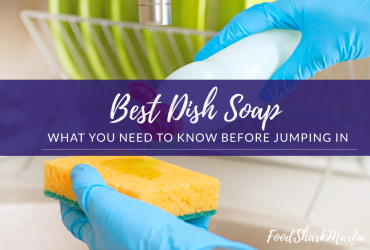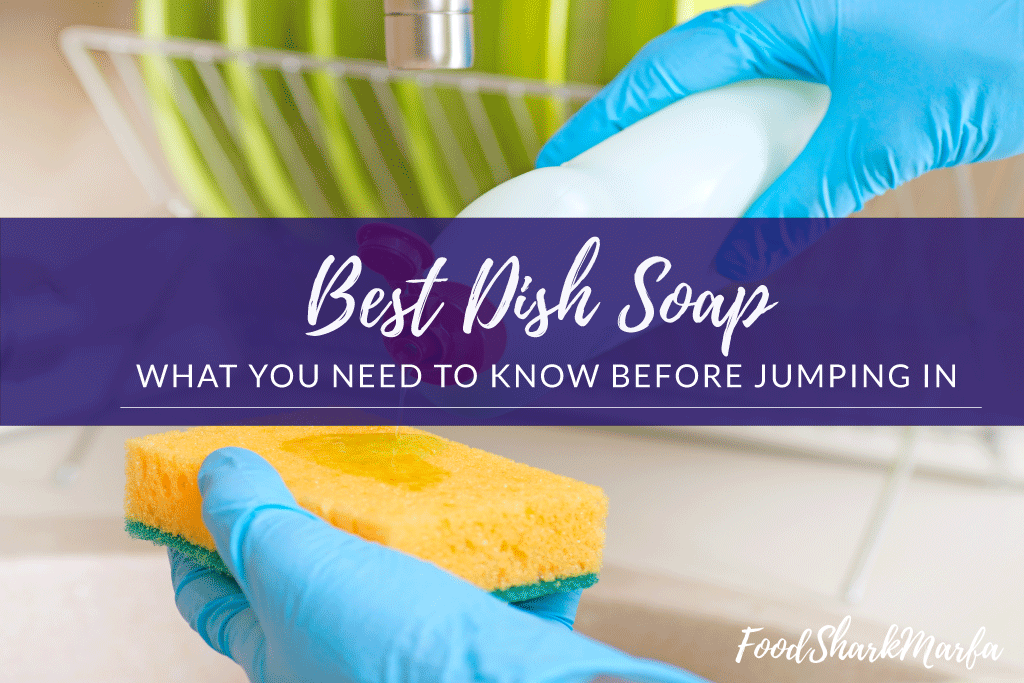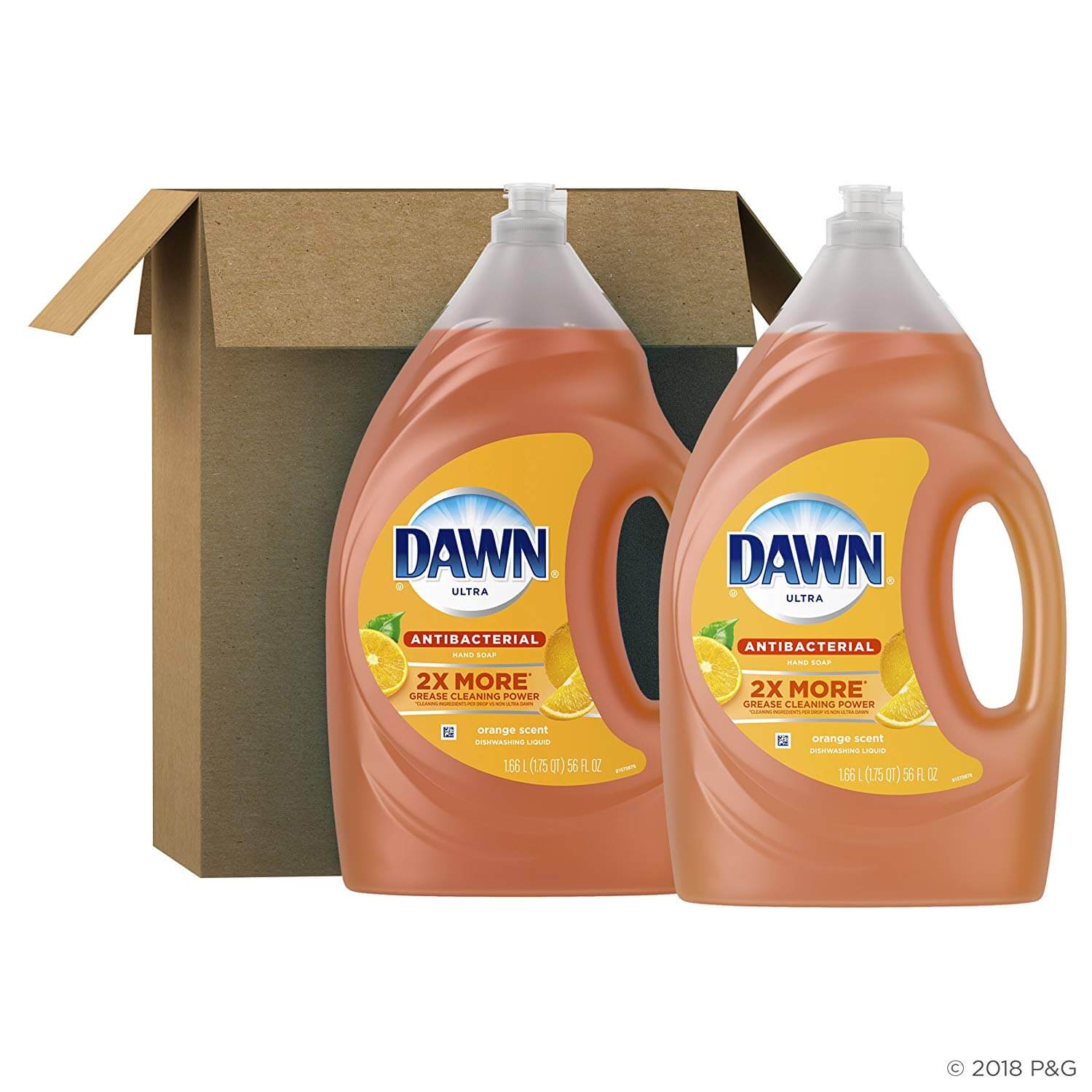Having a decent dish soap to hand is the easiest way to make light work of those dirty dishes and pans piled up in the sink. Dish soap is also handy for many of those light and heavier duty cleaning tasks around the home and garden. Many of us now have greater awareness of the ingredients in household products which we bring into our homes and in response to this more manufacturers now offer plant-based household products.
In this article, we look at the difference between ‘green’ or plant-based and regular dish soaps, as well as discussing why some of the ingredients in traditional dish soaps are of concern to some of us. We also review a number of plant-based and regular dish soaps to help you to choose the best dish soap for tackling those dirty dishes and other household jobs.
Quick Comparison: Top 10 Best Dish Soaps
1. Seventh Generation Dish Liquid Soap
The Seventh Generation dish soap (clementine zest & lemongrass) is a 95% USDA Certified Biobased Product. Made from plant-based ingredients, this soap has been scented with plant-based essential oils and botanical extracts and it is free from triclosan, phosphates, synthetic dyes and fragrances.
This does contain sodium lauryl sulfate (SLS) but this is sourced from coconut or plant oil rather than petrochemicals. This six pack of 25 fl. oz bottles of dish soap has not been tested on animals and is also EPA Safer Choice Certified and made by a Certified B Corporation.
Some buyers have found that the factory seal has been missing on some of the bottles which has increased the risk of leaks and the odd buyer has been dissatisfied with its ability to cut through grease. Although this product is predominantly plant-based, it does contain synthetic preservatives which not all buyers are happy with.Pros
Cons
2. Mrs. Meyer’s Clean Day Liquid Dish Soap
The triple pack of 16 fl. oz bottles of Mrs. Meyer’s Clean Day lemon verbena scent dish soap contains plant-based ingredients and is free from phthalates, parabens and animal-derived ingredients. This dish soap is not tested on animals and it is also biodegradable.
This dish soap does contain SLS which is plant-derived and synthetic (non-formaldehyde) preservatives. Some have found that the scent of this soap can be quite strong. Like any type of dish soap there can also be a risk of it drying out hands during use; the risk of which can be reduced by using gloves.Pros
Cons
3. Dawn Ultra Dishwashing Liquid Dish Soap
The Dawn Ultra dish soap contains three times as much grease cleaning power compared to the leading competitors non-concentrated brand. This is the original scent and comes as a twin pack of 56 fl. oz bottles. This dish soap does not contain any phosphates.
There can be a risk of these larger bottles leaking during shipping and a small number of buyers are unhappy with the scent of this particular product.Pros
Cons
4. Ajax Ultra Triple Action Liquid Dish Soap
The Ajax Ultra bleach alternative dish soap (lime) comes as a four pack of 52 fl. oz bottles. This lime-scented dish soap is free from phosphates. There can be a small risk of the bottles leaking during shipping and a small number of users consider that this is a watery dish soap which means you may need to use more.
Pros
Cons
5. Babyganics Foaming Dish & Bottle Soap
Made without any phosphates, phthalates, synthetic dyes or fragrances, the plant-based Babyganics Foaming Dish & Bottle Soap is dermatologist tested and non-allergenic. This is suitable for every day dish washing as well as cleaning baby bottles and it rinses clean without leaving residue. This fragrance free dish soap has not been tested on animals.
Coming as a twin pack of 32 fl. oz bottles, these are suitable for using in a dispenser although as this soap is thinner compared to other types of dish soap, extra care will be needed when pouring from the bottle and dispensing into water. Hands can also be more prone to drying and cracking when using this.Pros
Cons
6. Method Dish Soap
This six pack of 18 fl. oz pump bottles of Method dish soap (clementine) uses plant-based ingredients, including SLS from coconut and palm oils, for cleaning. This is also free from phthalates and Nonylphenol ethoxylates (NPEs), biodegradable and septic tank safe.
You may find that the pump dispenser may occasionally block and as a non-concentrated dish soap, you may need to use more than other types of soap. Some buyers have also found it less effective at clearing grease.Pros
Cons
7. Earth Friendly Products ECOS Dishmate Hypoallergenic Dish Soap
The ultra-concentrated Free & Clear ECOS dish soap (free & clear) is made from naturally derived cleaning agents, is hypoallergenic and biodegradable. This twin pack of 25 fl. oz unscented and septic tank safe soap is also free from any dyes and has not been tested on animals.
It is EPA Safer Choice Certified and has been produced with the use of renewable energy in the US. The manufacturer of this soap recommends that you apply a few drips to your wet cloth, brush or sponge and then scrub and rinse the dishes.
Some users have found this can be ineffective on cookware and you may need to keep adding soap to the sponge so that it can continue to clean. This will not foam as much as other types of dish soap and as more of a gel than liquid soap, not all users are keen on its consistency.Pros
Cons
8. Palmolive Ultra Dish Soap Oxy Power Degreaser
The phosphate free Palmolive Ultra Oxy power degreaser comes as a four pack of 32.5 fl. oz bottles. This is a heavier-duty dish soap able to remove food which has been stuck on for 24 hours and it will also fight surface stains such as coffee.
Some buyers are not as keen on the fragrance of this dish soap and a small number also consider that it is not as good at removing grease as comparable dish soaps.Pros
Cons
9. Dawn Antibacterial Dishwashing Liquid Dish Soap
With twice as much grease cleaning power per drop versus the leading bargain brand, the Dawn Ultra antibacterial dish soap (orange) also contains an antibacterial which makes it suitable for use as a hand washing soap also.
Coming as a twin pack of 56 fl. oz bottles, some buyers consider that the scent of this dish soap is not as pleasant as comparable dish soaps and if the bottles have not been sealed properly there is a chance that they may leak during shipping.Pros
Cons
10. Ecover Dish Soap
The six pack of 25 fl. oz bottles of Ecover dish soap (lime zest) contains renewable plant-based ingredients, including SLS from plant sources, and is biodegradable. As well as being made from recycled plastic, the bottle is made with Plantplastic and this dish soap has not been tested on animals.
As with any liquid, there can be a risk of leaks during shipping and some users have found that this can dry their hands out more than other types of dish soap.Pros
Cons
Things to Consider Before Buying Dish Soap
The main function of any dish soap or detergent is to remove grease and food debris off your dishes and cookware. Any dish soap will do this function; it is just that some are better at the task than others. Even if dish soaps are ‘tested’ against each other, it can be difficult to compare how well they work as it is almost impossible to treat dishes or pans with exactly the same amount of grease to give fair test results.
Even foods that may seem low grease can actually be rich in natural oils and burnt sugars are molecularly similar to oils as well; all of which our dish soap needs to break down properly.
As more bacteria grows on dishes left unwashed after a meal, you can help reduce bacteria by washing dishes straight after the meal. In restaurants, the FDA says that to kill bacteria, dishes need to be sanitized at around 171°F which is too hot for most of us washing dishes by hand. Instead, dishes need to be washed at 110°F, rinsed and then submerged in sanitizer for at least 30 seconds.
Washing dishes in water cooler than 110°F will still kill bacteria if they are sanitized afterwards and a basic sanitizer is a tablespoon of household bleach in one gallon of water – in fact this is the maximum that the FDA allow for any surfaces which come into contact with foods - so you would probably be fine with one teaspoon of bleach in a gallon of water.
If you do sanitize, then you should rinse off with clean water before drying or allow them to air dry completely before you use them.
For those of us who are wondering if there is a right way to do the dishes, the answer is no. It does not matter whether you add water or dish soap first, as long as they are mixed well, although in theory, if you add detergent first, it does help distribute it better through the water.
Manufacturers do not tend to provide any recommendations either – just that consumers should use them in the way that works best for them (and of course following any guidance on how much to use).
About Dish Soap and How It Works
Dish soap is not technically a soap in the world of chemistry. A true soap often reacts with minerals in water to form a solid – which is the soap scum that you may see stuck to the tiles inside your shower. A dish soap is actually a soap-like molecule which was developed to not react with minerals in the water. The technical term for this is a surface active agent or surfactant.
Surfactants are not just dish soap, they can be found in shampoos, toothpastes and many more products. Most dish soaps contain a blend of different surfactants to clean, foam and not produce scum. These surfactants can also irritate skin as they rinse away its oils. This is why those with more sensitive skin should wear dish washing gloves when using dish soap to minimize irritation to the hands.
Because water and oil repel each other chemically, it means that a surfactant, or we will keep it easier and refer to it as dish soap or detergent, is needed to allow the two different molecules to mix or allow you to remove grease from your dishes.
The dish soap contains two chemically different parts – one part neutral and one part electrically charged. When dish soap comes into contact with grease in the water, its neutral component interacts with the grease and the charged part interacts with water, forming a structure called a micelle.
Because the micelle has pulled the grease and water together, the water can now dissolve the grease and allow it to be rinsed away with the wastewater.
Dish Soap, SLS, SLES and Other Chemical Concerns
Sodium lauryl sulfate (SLS) and sodium lauryl ethyl sulfate (SLES) are two of the main surfactants found in dish soap. The Environmental Working Group class SLS as being low hazard.
SLS tends to be better at breaking up grease and will make more foam, however, this can form more soap scum and can cause more irritation to the skin. SLES – also called sodium laureth sulfate – is chemically similar to SLS and is made from this, although it does not form soap scum.
When SLES is made from SLS it causes a compound called 1,4-dioxane to be made. Although produced in a very small amount and some of it is removed from the detergent, a small amount of this 1,4-dioxane contaminant can end up in the bottle. This does not have to be listed on the ingredients as it is a contaminant rather than an ingredient.
1,4-dioxane is a probable human carcinogen as defined by the EPA. This means that it has been able to cause cancer in laboratory studies, although there is little data available on humans. Current limits of 1,4-dioxane in the food additive polysorbate are no more than 10 parts per million (ppm) and drinking water with 4 ppm for a day, or 0.4 ppm for ten days would not be expected to harm a child. There are other limits in place for sources of 1,4-dioxane.
There are currently no limits for levels of 1,4-dioxane in cosmetics or cleaning products, but research has shown that although it can be absorbed into the skin, it evaporates quickly which means that from the very small amounts contained in the product, a minimum amount actually gets absorbed into the skin.
Over ten years ago, testing of some popular products found higher levels of 1,4-dioxane in different products and manufacturers responding by lowering the levels. When these products were re-tested their average was 3 ppm or less of 1,4-dioxane.
Now consider the dilution of dish soap or shampoo in a gallon of water and it is easy to see how the amount of 1,4-dioxane in dish soap becomes virtually non-existent and is probably much less than that consumed through the diet.
When SLS and SLES enter wastewater systems they decompose during sewage treatment and they also decompose in soil, where wastewater ends if you have a septic tank. This means they are not a hazard in the environment, although you should keep dish soap to a minimum in wastewater as it can kill marine life.
Other ingredients in dish soaps identified by the Environment Working Group (EWG) that may be harmful include formaldehyde, ethanolamine, cocamide DEA, propylene glycol, sodium borate, sulfuric acid and triclosan.
The antibacterial agent triclosan is now banned from hand and body soaps, but this ban does not include dish soaps. Evidence remains mixed as to whether an antibacterial dish soap kills more germs than regular soaps.
Even fragrances can contain many chemicals and because fragrances are trade secrets, what they are composed of does not have to be published on ingredient lists. It is often fragrances which cause allergic reactions to dish soaps and other products. Fragrances can also contain phthalates. Found in many products, phthalates or plasticizers are now being phased out of some products such as toys. They have been shown to damage reproductive systems in animals, although there is little information on the effects of phthalates to our reproductive systems.
Phthalates (or their metabolites) have been found in people tested and although the FDA says they do not pose a risk in how they are currently used, they will continue to monitor the situation. The easiest way to avoid phthalates is by choosing fragrance free products as it is often the fragrances where the phthalates are. A number of manufacturers also produce ‘phthalate free’ products.
Phosphates are contained in some dish soaps and these contribute to algae build up in water systems. With some states banning high amounts of phosphates in dish soaps and garden fertilizers, manufacturers decided to reduce or even completely remove phosphates in their products to ensure they could meet different state requirements. This means that if your dish soap does still contain phosphates, the odds are high that it will soon be phosphate-free.
The EWG publish hazard ratings for dish detergents and other products based on their assessments of the ingredients of the products.
Regular, ‘Green’ and Baby Dish Detergents
The main difference between regular dish soaps and ‘eco’ or ‘green’ products is that the green products usually use ingredients, including SLS, from plant sources. These are also free from ‘non-essential’ ingredients such as dyes and they tend to be cruelty free and not tested on animals.
These eco products do cost more than regular products and if more product is needed to achieve the same level of grease-busting as a regular product, then as well as more overall expense, there can also be more plastic waste.
Anecdotally, it may be that plant-based cleaners produce more air emissions and solid waste although they are made from renewable ingredients, while regular detergents made from petrochemical surfactants consume more total energy as they are made from resources that would otherwise be used for energy.
Dish soaps for cleaning baby items such as bottles and toys may be marketed as baby dish soaps. These are usually fragrance and color free and do not contain any SLS, SLES or 1,4-dioaxane. They may also be marketed as including what may be described as ‘baby-safe ingredients’ which have been packaged in BPA-free bottles.
Conclusion
In this article we have considered how dish soap actually works and taken an in depth look at some of the ingredients in dish soaps which can be a concern for some of us. We have also looked at the differences between regular and plant-based dish soaps and the advantages and disadvantages of using one type over the other.
We have also reviewed ten of the best regular, green and baby dish soaps currently available. We do hope you have found these reviews helpful, and that they have assisted you in selecting the best dish soap for all your dish washing and household needs.













Related Posts
The 10 Best Kitchen Tongs in 2023
The 10 Best Avocado Oils for Cooking in 2023
The 18 Best Fruit Infuser Water Bottles in 2023